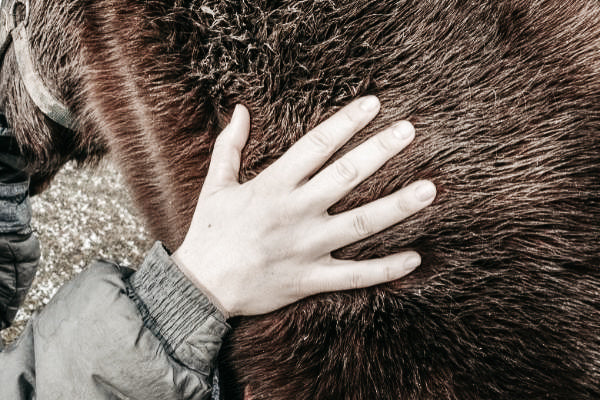
Cushing's syndrome in horses - incurable but still well under control?
Equine Cushing's syndrome, ECS for short, is now causing discomfort to many horse owners. Unfortunately, among horse diseases, Cushing's is one of the most common "diseases of prosperity". This term is actually relevant, because in reality the rather barren horse life of the past can no longer be compared with that of today.
We would like to explain to you in detail what triggers the disease and what needs to be done when diagnosing Cushing's syndrome in horses. Expert knowledge in particular can prevent, provide good assistance and, at best, help.
Definition of Cushing including causes
In addition to ECS, the term PPID (Pituitary Pars Intermedia Dysfunction) is now also used more often. The term comes from English and indicates that a pathologically enlarged pituitary gland plays an important role. Together with the adrenal cortex, hormones are produced in excess in the body. This offer is simply too much for the metabolism.
This means that the brain normally sends out dopamine substances. However, in Cushing's syndrome, some of these die. This is usually the cause of the brain gland's activity getting out of control.
The gland then releases a huge amount of substances to the adrenal cortex, which then uses messenger substances and hormones to produce cortisol (which is actually released during stress!). Cortisol causes increased blood sugar levels. The horse's organism is therefore on constant alert. This extensive malproduction weakens the animal's defenses in the long term and therefore triggers many symptoms of ECS.
Another cause of this disease can be long-term cortisone medication. Rapid progression of Cushing's is often clearly noticeable. This results in a serious metabolic disorder in the horse.
Food that is too high in sugar, high in energy and stress are also questioned as the cause of the suffering.
In terms of age, older animals (15 and over) usually struggle with PPID. Almost every fifth horse is affected. However, there are increasingly younger horses that are already suffering from it.
Symptoms of Cushing's syndrome
- faster sweating (impaired thermoregulation) and rapid fatigue
- increased water intake and urge to urinate (increased liver and kidney values!)
- the animal's activity decreases to the point of apathy
- weight loss
- Fat redistribution (e.g. b visible fat pads on the comb, croup or above the eyes)
- Muscle loss in the horse is clearly visible on the back
- the stomach hangs, often a slumped back
- possible insulin resistance
- disturbed fertility
- bad hoof horn
- sick animal tends to develop hoof ulcers
- Laminitis (an issue in 50 - 80% of all affected horses)
- Dental disease or Cushing's mouth ulcers
- Loss of appetite
- Wounds heal poorly
- disturbed coat change in horses (long, shaggy, curly or wavy hair = hirsutism)
- possible degeneration of bone, muscle and connective tissue
How is Cushing's syndrome diagnosed?
The vet will of course ask and look for these symptoms. To confirm the entire diagnosis, a blood test is appropriate. The ACTH value can be determined here. This determination is also very important in order to differentiate between similar EMS diseases.
Critical attention should be paid to values >50 pg/ml. If the value is over >100 pg/ml, this undoubtedly indicates Cushing's syndrome in horses.
A TRH stimulation test can also provide information as to whether the animal is ill. The cortisol value is determined here. The TRH hormone is then added and the measurement is taken again. If the value increases significantly within half an hour, the ECS closes. In combination with the dexamethasone test, a very reliable detection situation.
Therapy options for a Cushing horse
Unfortunately, this serious metabolic disorder in horses cannot be cured. But that doesn't necessarily mean the worst. Thanks to a pergolide preparation prescribed by a veterinarian and simultaneous, needs-based administration of certain micronutrients and bioactive substances, functioning metabolic activities can still be maintained. The whole thing is called “palliative therapy”. She now accompanies the animal virtually until the end of its life.
Possible procedure:
- a pergolide drug (stimulates the release of dopamine) is prescribed
- Monk's pepper (also said to provide positive support for ECS horses)
- Micronutrients
- bioactive substances
- increased need for antioxidants (vitamins)
You can also see:
Dietary measures are required!
Example feeding of a Cushing horse
Basefood:
High-quality hay and feed straw are important for healthy intestinal function. For animals at risk of laminitis, it makes sense to water the hay. But be careful: the nutrients also disappear!
If the horse is too thin, high-quality protein (soy meal) and restorative amino acids can be fed.
Energy food:
Grain is deliberately avoided. No molasses muesli! They just trigger a high glucose and insulin response. Unmolassed beet pulp and oils (e.g. b Linseed oil).
Fruit, carrots and too much grass are not ideal. There's a lot of glucose hiding here.
Mineral food:
The increased need for micronutrients can be determined by the veterinarian. This supplementary feeding is very important in order to deal with nutrient imbalances. It supports all processes in the body and can actually slow the progression of Cushing's syndrome in horses.
Bioactive plant substances strengthen the immune system and are also an important part of the diet.
Important:
Follow-up examinations and regular monitoring checks make it clear what is still missing. This is the only way to ensure the exact dosage of medicine, minerals, nutrients and nutrition. Your vet will definitely be there to help and advise you.
Can you prevent Cushing's in horses?
Species-appropriate husbandry, social contact, sufficient exercise and, above all, appropriate feeding are certainly the best prevention for ECS. Of course also for all other horse diseases.
However, being overweight plays a crucial role and should be avoided. Movement incentives in an open or active stable, which sometimes also have digital feed monitoring, are recommended. In general, keep exercise and feeding in balance whenever possible. That's "half the battle" and an important health formula.
But Cushing - what now?
Absolute to do: Carry out active health management.
- Adhere to daily medication (a pill bottle with marked days of the week is ideal for owners/riding participants)
- do not miss the vet's checks
-continue regular dental and hoof care
- movement adapted to the degree of illness
- an individual ration calculation when feeding is desirable
- if necessary, clip the horse in spring/summer
- ensure good, absorbent bedding when there is a strong urge to urinate
Your partner will definitely feel better quickly. In fact, early detection has a really good prognosis. All the best to you!
Discover more posts

Fecal water in horses - information is often crucial
Unsightly sight for onlookers: brown streaks that run down from the horse's rear along the hind legs. Sometimes sticky, sometimes still wet, they keep horse owners on their toes. Cl...
Continue reading
Pasture farming: advantages and disadvantages at a glance
Like all animals, horses also have individual needs. There are a few things to consider, especially when it comes to posture. Different forms of husbandry sometimes come closer and sometimes l...
Continue reading
